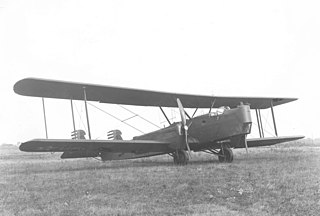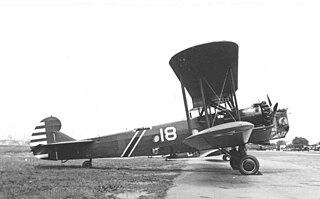
The Curtiss Falcon was a family of military biplane aircraft built by the American aircraft manufacturer Curtiss Aeroplane and Motor Company during the 1920s. Most saw service as part of the United States Army Air Corps as observation aircraft with the designations O-1 and O-11, or as the attack aircraft designated the A-3 Falcon.

The Curtiss A-8 was a low-wing monoplane ground-attack aircraft built by the United States company Curtiss Aeroplane and Motor Company, designed in response to a 1929 United States Army Air Corps requirement for an attack aircraft to replace the A-3 Falcon. The Model 59 "Shrike" was designated XA-8.

The Boeing XB-15 was a United States bomber aircraft designed in 1934 as a test for the United States Army Air Corps (USAAC) to see if it would be possible to build a heavy bomber with a 5,000 mi (8,000 km) range. For a year beginning in mid-1935 it was designated the XBLR-1. When it first flew in 1937, it was the most massive and voluminous airplane ever built in the US. It set a number of load-to-altitude records for land-based aircraft, including carrying a 31,205 lb (14,154 kg) payload to 8,200 ft (2,500 m) on 30 July 1939.

The Huff-Daland XB-1 was a prototype bomber aircraft built for the United States Army Air Corps.

The Curtiss B-2 Condor was a 1920s United States bomber aircraft. It was a descendant of the Martin NBS-1, which was built by the Curtiss Aeroplane and Motor Company for the Glenn L. Martin Company. There were a few differences, such as stronger materials and different engines, but they were relatively minor.

The Keystone B-4 was a biplane bomber, built by the Keystone Aircraft company for the United States Army Air Corps.

The Keystone B-5 is a light bomber made by the Keystone Aircraft company for the United States Army Air Corps in the early 1930s. The B-5A was a Keystone B-3A with Wright Cyclone rather than Pratt & Whitney engines.

The Keystone B-6 was a biplane bomber developed by the Keystone Aircraft company for the United States Army Air Corps.

The Douglas Y1B-7 was a 1930s American bomber aircraft. It was the first US monoplane given the B- 'bomber' designation. The monoplane was more practical and less expensive than the biplane, and the United States Army Air Corps chose to experiment with monoplanes for this reason. At the time the XB-7 was ordered, it was being tested by Douglas Aircraft as an observational plane.
The Martin XB-16, company designation Model 145, was a projected heavy bomber designed in the United States during the 1930s.

The Douglas XB-19 was a four-engined, piston-driven heavy bomber produced by the Douglas Aircraft Company for the United States Army Air Forces (USAAF) during the early 1940s. The design was originally given the designation XBLR-2. It was the largest bomber built for the USAAF until 1946, with the Convair B-36 surpassing it in size.
The Boeing Y1B-20 was designed as an improvement on the Boeing XB-15 It was slightly larger than its predecessor, and was intended to use much more powerful engines. It was presented to the Army in early 1938, and two orders were placed soon after. The order was reversed before construction began.

The North American XB-28 Dragon (NA-63) was an aircraft proposed by North American Aviation to fill a strong need in the United States Army Air Corps for a high-altitude medium bomber. It never entered production, with only two prototypes being built.
The Douglas XB-31 was the design submitted by Douglas after the request by the United States Army Air Forces for a very heavy bomber aircraft, the same request that led to the Boeing B-29 Superfortress, Lockheed XB-30, and Consolidated B-32 Dominator.

The North American O-47 is an American observation fixed-wing aircraft monoplane designed in the mid-1930s and used by the United States Army Air Corps during the Second World War. It has a low-wing configuration, retractable landing gear, and a three-blade propeller.

The Boeing YB-9 was the first all-metal monoplane bomber aircraft designed for the United States Army Air Corps. The YB-9 was a much enlarged twin-engine development of Boeing's single-engine Model 200 Monomail commercial transport.

The Douglas O-2 was a 1920s American observation aircraft built by the Douglas Aircraft Company, powered by the Liberty engine of WW1 fame, with some later variants using other engines. It was developed into several version, with 879 being produced in total. It was used in combat by the Chinese Air Force in the 1930s and also was that basis for a successful mailplane version.

The Keystone LB-6 and LB-7 were 1920s American light bombers, built by the Keystone Aircraft company for the United States Army Air Corps, called Panther by the company, but adoption of the name was rejected by the U.S. Army.
The Keystone XO-15 was an American prototype observation aircraft, built by the Keystone Aircraft Corporation for the United States Army Air Corps, First flown in 1930, only a single prototype was built.
The Martin XLB-4 was a 1920s proposal for a light bomber by the Glenn L. Martin Company.
















